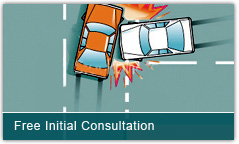EDR "Black Box" Downloads
The technical term for an automotive “Black Box” is the Event Data Recorder (EDR). The EDR can be a variety of devices that record onboard information and vary according to make and model of the vehicle. GM has a Sensing Diagnostic Module (SDM) and a Rollover Sensor (ROS). Fords have a Restraint Control Module (RCM) as well as a Powertrain Control Module (PCM). Chryslers have an Occupant Restraint Controller (ORC).
The SDM, RCM, ORC are called Airbag Control Modules (ACM). These devices measure an acceleration pulse and determine whether there is sufficient severity to warrant the deployment of the airbags. Once the algorithm “wakes up” it then must decide, very quickly, whether the airbags should be deployed. If the airbags do deploy, there is a recording of the crash severity (Delta-V) and there may be additional information such as vehicle speed, seatbelt usage, throttle position and brake on/off data, among others. In some situations there can be data captured without airbag deployment. Our engineers can help you determine if your vehicle may have stored data without a deployment.
This information has been found to be extremely useful in the reconstruction of vehicle accidents and all attempts are made to gather this information if possible. It is important to realize that not all systems can be downloaded at this time. The crash data retrieval system (CDR) that we use is presently only able to download GM, Ford and Chrysler vehicles, and several other smaller manufacturers such as Isuzu, Mitsubishi, Sterling and Suzuki. Unfortunately, other manufacturers, particularly those based overseas, are not supported by the CDR software. There are rare occasions when data from these vehicles can be obtained, so please contact us for further information.
The CDR system can be plugged into the port on the underside of the dash (similar to the outlet a mechanic would use) or directly into the “black box” which is found inside the vehicle or engine compartment. The “black box” can be downloaded on site, or at our lab if it has been removed. To determine if the vehicle in question is downloadable, click here for a list of presently supported vehicles.
Importantly, we consider the crash data a “supplement” to a proper accident reconstruction. Typically, the downloaded information corroborates previous findings with respect to impact speed, Delta-V/Severity, seatbelt use and pre-crash behavior.
This information is particularly useful in the moments leading up to the collision, as very often there is no physical evidence that can be used to establish what the driver was doing. For example, a vigorous accident reconstruction can determine the speed of the vehicle with good precision at impact, however it is often not known whether that vehicle was accelerating, coasting, or braking in the seconds leading up to the crash. With “black box” data, a history of up to twenty-five seconds can establish these parameters.
Usually the download of the CDR data is relatively straight forward, however there are some circumstances where evidence spoliation can occur if the “black box” is improperly accessed. You can trust the engineers at FDi to not only properly download the data but also analyze the data. We have seen many cases where the data is corrupted. Fortunately, there are many ways to validate and verify information which was downloaded.





